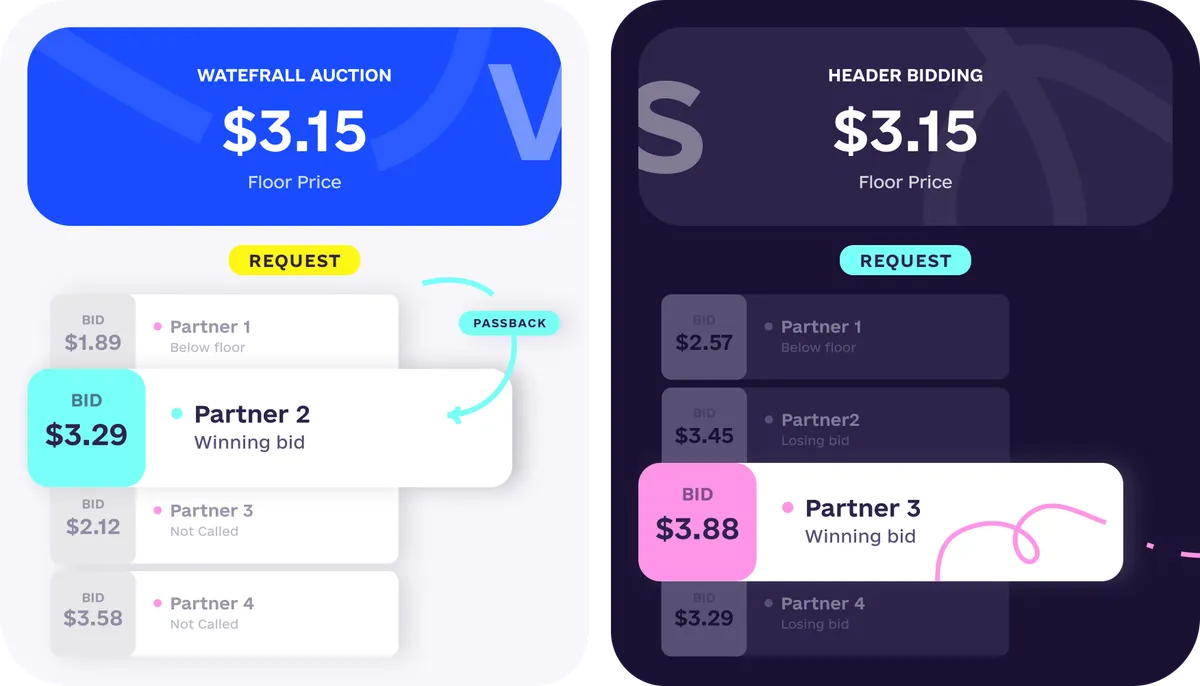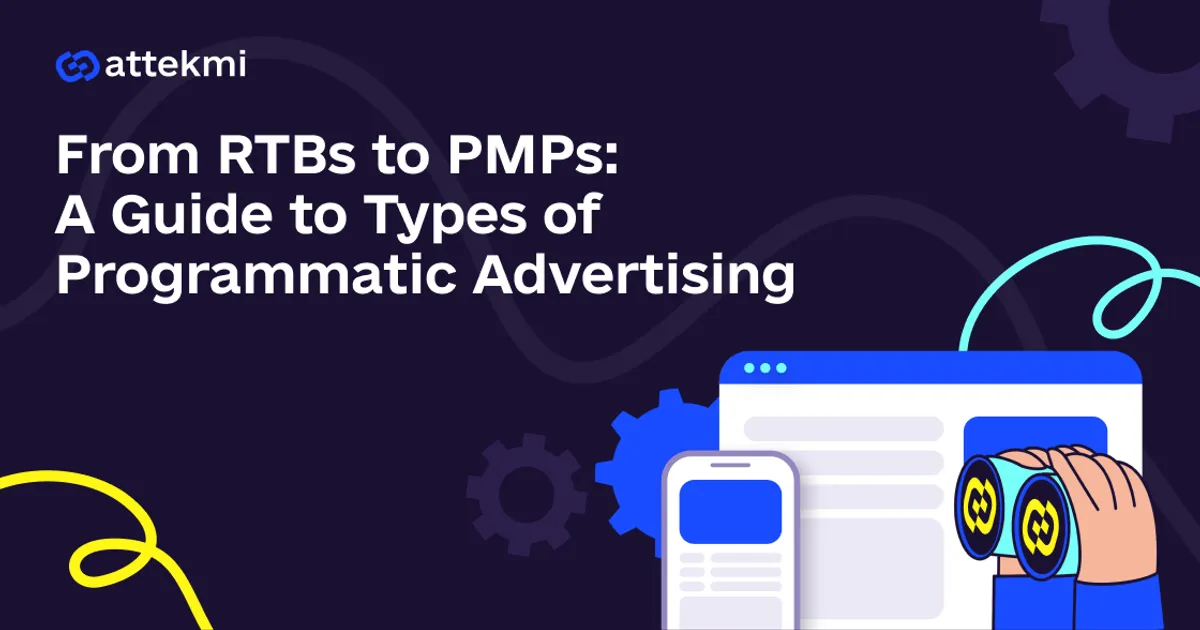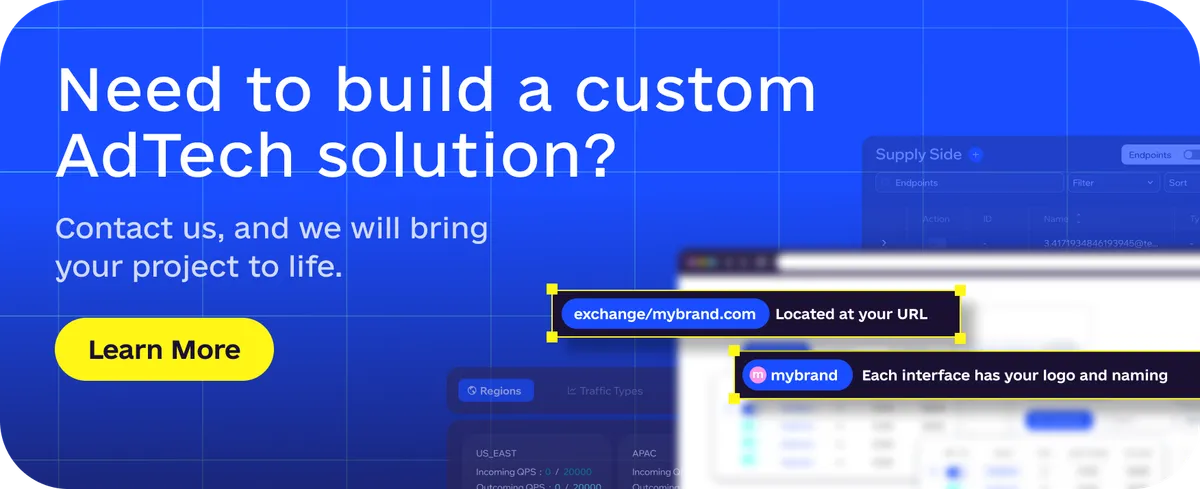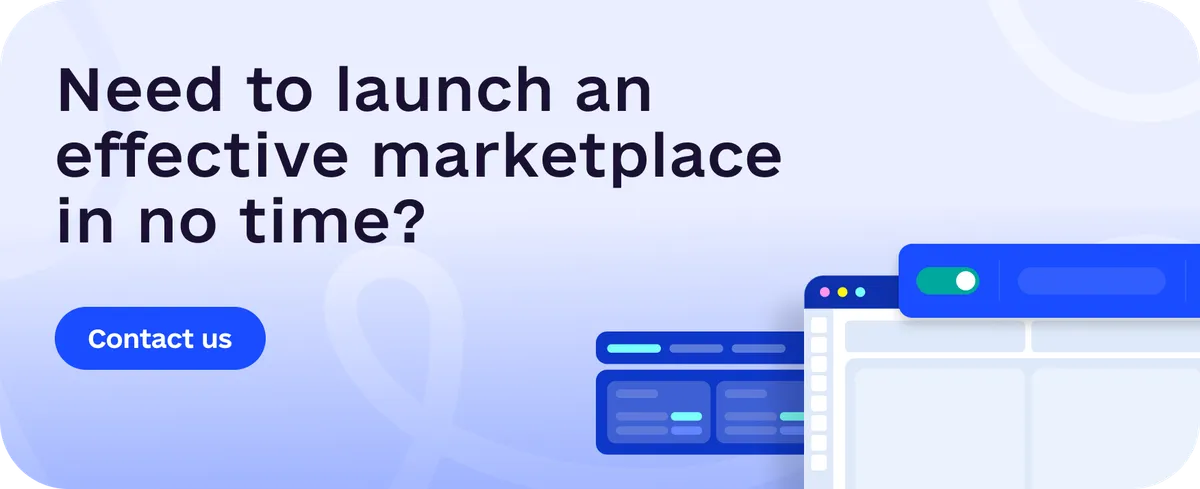Programmatic technology allows for automating the process of buying and selling ad space, which makes it preferable for both marketers and publishers. However, real-time bidding, which is most often associated with programmatic, is not the only option available.
How to make a choice between different programmatic advertising models? You need to know their pros and cons, as well as identify your goals.
Relying on our extensive experience with ad exchange solutions and the knowledge of the programmatic industry, we will review different types of programmatic advertising and explore their benefits and challenges. We will also look at the latest programmatic trends shaping the industry.
Key Takeaways
There are four main types of programmatic advertising: RTB (real-time bidding), PMP (private marketplace), programmatic guaranteed, and preferred deals – each offering a different balance of transparency, control, and cost.
RTB is the most budget-friendly and widely used model, but it offers the least control and transparency. PMP and programmatic guaranteed offer more control and higher inventory quality at a higher cost.
Emerging trends like header bidding, supply-path optimization (SPO), and AI-driven automation are reshaping how advertisers and publishers optimize their programmatic strategies in 2025.
Choosing the right model depends on your budget, control requirements, and access to premium inventory, making strategic alignment with business goals essential.
Attekmi’s ad exchange solutions support a range of integration types, including cross-integration bidding (e.g., VAST to RTB), which provides platform owners with ultimate flexibility.
Programmatic Advertising in Numbers: Market Size and Growth
Before we dive deep into different programmatic advertising models, let’s explore the current and forecasted state of the market. So, here are some statistical facts to pay attention to:
Global programmatic advertising spending market size is estimated at around $131 billion in 2024 and expected to surpass $320 billion by 2033, achieving a CAGR of 10.42%.
Nowadays, programmatic campaigns span across more than 80 countries.
The USA is a leader in terms of global programmatic ad spend – over 52% of global transactions in 2024.
Mobile ads lead the market, accounting for over 63% of total programmatic impressions delivered in the year 2024.
On average, programmatic campaigns target 2.7 devices per user.
What drives the growth of the programmatic market? First of all, that is automation capabilities. Programmatic technology streamlines the process of buying and selling ad space. Secondly, there is a wide selection of formats and environments. Apart from standard traffic channels like desktop, mobile web, and in-app, programmatic ads can be delivered via CTV and digital out-of-home devices, in the audio format, and so on. Thirdly, modern programmatic platforms evolve continuously. They are getting equipped with more and more sophisticated features, enabling users to ensure precise targeting, optimize spending, etc.
For advertisers, all these factors and statistical information mean the following: in 2025, adopting the programmatic approach is virtually a must. Otherwise, it may be challenging for you to remain competitive and drive conversions.4 types of programmatic advertising
So, here are four programmatic advertising types that are important to be aware of.
4 types of programmatic advertising
So, here are four programmatic advertising types that are important to be aware of.
Model | Key Pros | Key Cons | Who may choose it |
RTB |
|
| Advertisers and publishers who are only entering the programmatic environment |
PMP |
|
| Advertisers and publishers who strive for greater control over the ad operations |
Programmatic Guaranteed |
|
| Advertisers and publishers who have enough data to select the right partners and start negotiating with them |
Preferred Deals |
|
| Advertisers and publishers who strive to build direct but still flexible relationships |
RTB (real-time bidding)
Being the most common form of programmatic, RTB in marketing implies purchasing and selling ad inventory via a real-time auction. When an impression opportunity arises, advertisers compete for the ad space, and the winning advertisement is then delivered to a publisher and displayed to users.
Benefits
For media buyers, RTB allows for more precise targeting, higher relevance of the ads, and an increase in ROI.
For publishers, RTB means access to a wider pool of marketers.
Challenges
The lack of transparency and control.
Publishers are unaware of marketers bidding for their inventory.
Ads can end up next to inappropriate content, causing potential risks to advertisers’ reputations.
PMP (private marketplace)
PMP also operates on an auction basis, but only selected marketers can participate. Such a marketplace can be invite-only, which implies access to the premium ad inventory. Alternatively, it can be available to all the advertisers who meet publishers’ requirements. This ensures a wider range of inventory, but its quality may vary.
Benefits
Access to high-quality publishers for advertisers.
Publishers get an opportunity to increase their income and deliver more relevant ads.
Publishers know who advertisers are, and vice versa. This ensures greater transparency and control, as well as improved brand safety.
Challenges
For media buyers, bidding on a PMP is usually more expensive.
For publishers, there is a risk of underestimating the demand for their exclusive ad space.
PMP is not immune to ad fraud.
Programmatic guaranteed
Programmatic guaranteed vs PMP is a common comparison in the digital advertising world. Programmatic guaranteed removes the ad exchange from the process of buying and selling ad inventory. Advertisers purchase it directly from publishers. Thus, a marketer agrees to buy a certain number of impressions, while a publisher agrees to deliver the specified number of impressions for a fixed price.
Benefits
A high level of transparency for all the parties.
Advertisers can reach specific audiences on specific websites while having access to premium ad slots and eliminating pricing and delivery uncertainties.
Publishers get high-quality ads relevant to their audiences.
The risk of ad fraud is low since there are only two parties involved in the process.
Challenges
Getting into programmatic guaranteed often requires publishers to have a high-performing website.
A potentially limited selection of inventory.
Preferred deals
This model implies a publisher providing a buyer with preferential access to their ad inventory during an auction (after negotiating pricing and other conditions). This means that a selected advertiser will be the first in the line when the auction starts.
Benefits
Advertisers benefit from flexibility and improved brand safety.
Publishers have improved price and quality control.
Preferred deals ensure greater transparency, as they are negotiated between only two parties.
Challenges
Advertisers are not obliged to bid on the ad space, so certain impressions may remain unfilled.
Marketers still take part in the auction since the deal is not guaranteed.
Each of the above-mentioned models serves different purposes and has its specific pros and cons. To make it a bit easier for you to make a choice, let’s summarize the key differences:
Emerging trends in programmatic advertising
As the programmatic landscape keeps evolving, it is crucial to stay on top of trends. Here they are.
Header bidding
Header bidding means offering ad inventory to multiple advertisers at once instead of offering it first to the top-tier buyers, then to the next tier, and so on. Publishers benefit from increased competition and the maximum value of inventory, while advertisers have equal opportunities.

SPO (supply-path optimization)
SPO is about identifying the number of intermediaries between a demand-side platform and a publisher and optimizing this path to make it as short and profitable as possible. For instance, this can involve establishing direct connections with publishers, working only with a selected number of supply-side platforms, etc. Adopting SPO also allows advertisers to avoid duplicated auctions during header bidding.
The rise of AI
The operation of programmatic advertising heavily relies on AI, but there are many more applications entering the stage. For instance, AI can be used for content generation, improved targeting and personalization, more effective quality assurance, and even campaign planning. It is important to keep an eye on its rapid advancements that bring benefits both to marketers and publishers.
How to Choose the Right Programmatic Model
To choose the right programmatic advertising model, you, as a marketer, need to consider the following key factors:
Budget
RTB is usually the most budget-friendly option, especially when you support your marketing effort with your DSP budget optimization features. In turn, for instance, programmatic guaranteed tends to be more expensive, but, after negotiations, these expenses are fixed.
The Level of Control
RTB implies the least possible control, while PMP offers a higher level. In turn, those who strive for ultimate control should consider programmatic guaranteed. As for preferred deals, that is a good option for those who require both control and flexibility.
The Type of Inventory
RTB offers a wide selection of inventory, but it can be hard to reach premium ad space via this model. With PMP, programmatic guaranteed, and preferred deals, this task gets easier. Additionally, programmatic guaranteed means that you purchase specific ad spots – those that you require.
When making a choice, make sure to keep your goals in mind – they should be your priority.
Consider Attekmi your trusted partner
For ad exchange owners, it is crucial to meet the needs of advertisers and publishers to keep their platforms profitable. Using solutions like those offered by Attekmi can significantly simplify this task.
Here are the integration options that we support:
OpenRTB 2.6
VAST to RTB
VAST to All
VAST to VAST
JS tags
Header bidding
DSP and SSP connectors for specific integrations
Besides, it offers multiple programmatic targeting options, as well as different types of programmatic ads, including banner, video, audio, native, pop, and CTV ads.
Note that our selection of ad exchange solutions can meet any needs:
AdEx Basic: an entry-level platform with basic functionalities, a perfect choice for beginners.
AdEx Plus: an enhanced version of AdEx Basic, with additional features and certain scalability opportunities.
AdEx Enterprise: a platform with advanced capabilities and an ultimately scalable nature.
White Label Ad Exchange: a fully customizable solution, from UI personalization to custom on-request feature development.
With Attekmi, you do not have to build an ad exchange platform from scratch. Instead, you can start earning on media trading quickly. And since our solutions are regularly updated with new functionalities, you can rest assured that your ad exchange will remain competitive.
In addition, we offer the following services:
Custom AdTech development: We can bring your unique project to life.
Ad Ops outstaffing: We can train an expert specifically for your business so that you can focus on your core tasks while your operations run smoothly.
AdTech and Ad Ops training: We are ready to share our knowledge and help you master new skills.
At Attekmi, we operate on a turnkey basis and are ready to meet all your AdTech requirements.
Does Attekmi seem to be the right solution? Then let’s get in touch!
FAQ
Among different types of programmatic advertising, there are four main options to consider: RTB (real-time bidding), PMP (private marketplace), programmatic guaranteed, and preferred deals. Each of them has its specific benefits and challenges, so it is essential for advertisers and publishers to understand their needs and possibilities before choosing a model.
Choosing a model depends on multiple factors, like the volume of traffic on the publisher’s website, the advertiser’s budget, etc. Both parties have to understand their requirements and continuously analyze their performance under the selected model to be able to adjust their strategies.
The fewer parties are involved in the process, the better. Considering the types of programmatic advertising explained in this guide, programmatic guaranteed implies direct deals between media buyers and publishers, meaning that the risk of ad fraud and malicious activities decreases.
 By Iryna Kozirevych
By Iryna Kozirevych

